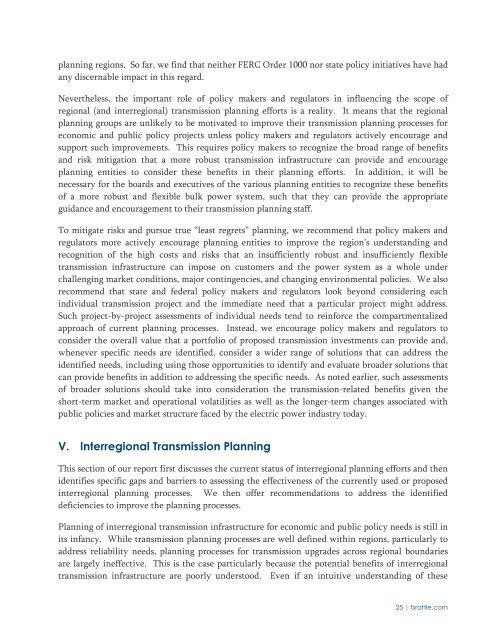THE BRATTLE GROUP
pvrbYG
pvrbYG
You also want an ePaper? Increase the reach of your titles
YUMPU automatically turns print PDFs into web optimized ePapers that Google loves.
planning regions. So far, we find that neither FERC Order 1000 nor state policy initiatives have had<br />
any discernable impact in this regard.<br />
Nevertheless, the important role of policy makers and regulators in influencing the scope of<br />
regional (and interregional) transmission planning efforts is a reality. It means that the regional<br />
planning groups are unlikely to be motivated to improve their transmission planning processes for<br />
economic and public policy projects unless policy makers and regulators actively encourage and<br />
support such improvements. This requires policy makers to recognize the broad range of benefits<br />
and risk mitigation that a more robust transmission infrastructure can provide and encourage<br />
planning entities to consider these benefits in their planning efforts. In addition, it will be<br />
necessary for the boards and executives of the various planning entities to recognize these benefits<br />
of a more robust and flexible bulk power system, such that they can provide the appropriate<br />
guidance and encouragement to their transmission planning staff.<br />
To mitigate risks and pursue true “least regrets” planning, we recommend that policy makers and<br />
regulators more actively encourage planning entities to improve the region’s understanding and<br />
recognition of the high costs and risks that an insufficiently robust and insufficiently flexible<br />
transmission infrastructure can impose on customers and the power system as a whole under<br />
challenging market conditions, major contingencies, and changing environmental policies. We also<br />
recommend that state and federal policy makers and regulators look beyond considering each<br />
individual transmission project and the immediate need that a particular project might address.<br />
Such project-by-project assessments of individual needs tend to reinforce the compartmentalized<br />
approach of current planning processes. Instead, we encourage policy makers and regulators to<br />
consider the overall value that a portfolio of proposed transmission investments can provide and,<br />
whenever specific needs are identified, consider a wider range of solutions that can address the<br />
identified needs, including using those opportunities to identify and evaluate broader solutions that<br />
can provide benefits in addition to addressing the specific needs. As noted earlier, such assessments<br />
of broader solutions should take into consideration the transmission-related benefits given the<br />
short-term market and operational volatilities as well as the longer-term changes associated with<br />
public policies and market structure faced by the electric power industry today.<br />
V. Interregional Transmission Planning<br />
This section of our report first discusses the current status of interregional planning efforts and then<br />
identifies specific gaps and barriers to assessing the effectiveness of the currently used or proposed<br />
interregional planning processes. We then offer recommendations to address the identified<br />
deficiencies to improve the planning processes.<br />
Planning of interregional transmission infrastructure for economic and public policy needs is still in<br />
its infancy. While transmission planning processes are well defined within regions, particularly to<br />
address reliability needs, planning processes for transmission upgrades across regional boundaries<br />
are largely ineffective. This is the case particularly because the potential benefits of interregional<br />
transmission infrastructure are poorly understood. Even if an intuitive understanding of these<br />
25 | brattle.com


